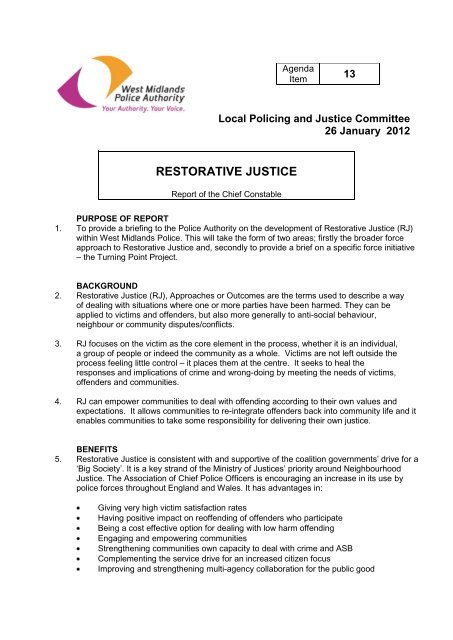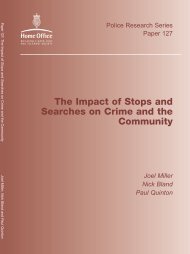purpose of report - West Midlands Police and Crime Commissioner
purpose of report - West Midlands Police and Crime Commissioner
purpose of report - West Midlands Police and Crime Commissioner
Create successful ePaper yourself
Turn your PDF publications into a flip-book with our unique Google optimized e-Paper software.
AgendaItem13Local Policing <strong>and</strong> Justice Committee26 January 2012RESTORATIVE JUSTICEReport <strong>of</strong> the Chief ConstablePURPOSE OF REPORT1. To provide a briefing to the <strong>Police</strong> Authority on the development <strong>of</strong> Restorative Justice (RJ)within <strong>West</strong> <strong>Midl<strong>and</strong>s</strong> <strong>Police</strong>. This will take the form <strong>of</strong> two areas; firstly the broader forceapproach to Restorative Justice <strong>and</strong>, secondly to provide a brief on a specific force initiative– the Turning Point Project.BACKGROUND2. Restorative Justice (RJ), Approaches or Outcomes are the terms used to describe a way<strong>of</strong> dealing with situations where one or more parties have been harmed. They can beapplied to victims <strong>and</strong> <strong>of</strong>fenders, but also more generally to anti-social behaviour,neighbour or community disputes/conflicts.3. RJ focuses on the victim as the core element in the process, whether it is an individual,a group <strong>of</strong> people or indeed the community as a whole. Victims are not left outside theprocess feeling little control – it places them at the centre. It seeks to heal theresponses <strong>and</strong> implications <strong>of</strong> crime <strong>and</strong> wrong-doing by meeting the needs <strong>of</strong> victims,<strong>of</strong>fenders <strong>and</strong> communities.4. RJ can empower communities to deal with <strong>of</strong>fending according to their own values <strong>and</strong>expectations. It allows communities to re-integrate <strong>of</strong>fenders back into community life <strong>and</strong> itenables communities to take some responsibility for delivering their own justice.BENEFITS5. Restorative Justice is consistent with <strong>and</strong> supportive <strong>of</strong> the coalition governments’ drive for a‘Big Society’. It is a key str<strong>and</strong> <strong>of</strong> the Ministry <strong>of</strong> Justices’ priority around NeighbourhoodJustice. The Association <strong>of</strong> Chief <strong>Police</strong> Officers is encouraging an increase in its use bypolice forces throughout Engl<strong>and</strong> <strong>and</strong> Wales. It has advantages in:Giving very high victim satisfaction ratesHaving positive impact on re<strong>of</strong>fending <strong>of</strong> <strong>of</strong>fenders who participateBeing a cost effective option for dealing with low harm <strong>of</strong>fendingEngaging <strong>and</strong> empowering communitiesStrengthening communities own capacity to deal with crime <strong>and</strong> ASBComplementing the service drive for an increased citizen focusImproving <strong>and</strong> strengthening multi-agency collaboration for the public good
CURRENT POSITION6. <strong>West</strong> <strong>Midl<strong>and</strong>s</strong> <strong>Police</strong> are aware <strong>of</strong> the potential benefits from developing restorativeapproaches. We have conducted some initial research <strong>and</strong> have comm<strong>and</strong> teamapproval to investigate the most appropriate <strong>and</strong> effective manner to incorporate itfurther into our working practices.7. Resources have been shifted with Community Justice <strong>and</strong> Custody to increase ourcapacity to speed up our work in this area – this will start to have an impact fromDecember this year.8. Community Resolutions are now embedded within our working practices, <strong>and</strong> thesecan <strong>and</strong> do include restorative approaches. The <strong>Police</strong> Authority has previously beenprovided with information on our use <strong>of</strong> these resolutions. We have identified that thereis scope to increase their restorative impact, <strong>and</strong> therefore maximize the benefitsgained. The development <strong>of</strong> Community Resolutions is occurring in concert with thedevelopment <strong>of</strong> a restorative strategy – both will be mutually compatible <strong>and</strong>supportive.9. The force has also given an expression <strong>of</strong> interest in taking part in a national series <strong>of</strong>pilots <strong>of</strong> one particular style <strong>of</strong> delivery <strong>of</strong> restorative conferencing – NeighbourhoodJustice Panels. It is likely that such panels will be most effective if managed <strong>and</strong>overseen by organisations outside <strong>of</strong> the police service, <strong>and</strong> we are currently workingwith partners to see who else is interested in collaborating with us to develop a localsolution. The Ministry <strong>of</strong> Justice is considering bids <strong>and</strong> will determine which willqualify for their independent assessment. There is the opportunity, if we so wish, to goahead with a local pilot even if ours is not to be a part <strong>of</strong> the national assessment.PLANNED DEVELOPMENTS10. The coalition government has identified a ministerial priority <strong>of</strong> ‘Neighbourhood Justice’within its strategic plan. It is clear that restorative justice is a key thread <strong>of</strong> this workstream. Although some drivers for this priority are clear, the police service has littleconcrete direction from the government at this stage. The force will be developingrestorative justice within the Neighbourhood Justice work stream, with leadership fromACC Forsyth, <strong>and</strong> with Community Justice <strong>and</strong> Custody as the departmental lead. Theimpact <strong>of</strong> this work goes beyond ‘justice’ (i.e. limited to crime) issues <strong>and</strong> we will beworking closely with Local Policing <strong>and</strong> Local Policing Units, as well as a wide variety<strong>of</strong> partners.11. The development <strong>of</strong> restorative justice therefore is under two, merging streams:In internal review <strong>and</strong> ‘refresh’ <strong>of</strong> Community Resolutions. The core <strong>of</strong> this is a newpolicy, which retains the ethos but updates some <strong>of</strong> the guidance. We are about toconsult on the draft, both internally <strong>and</strong> with our CJS partners. This will include a faceto face consultation in the New Year. The new policy incorporates restorativeprinciples.The development <strong>of</strong> a strategy to develop Neighbourhood Justice. This has coreprinciples <strong>of</strong> reducing re<strong>of</strong>fending; engaging <strong>and</strong> empowering local communities;increased transparency <strong>and</strong> cost-effectiveness. The development <strong>of</strong> this strategy willbe done in consultation with partners, the third sector <strong>and</strong> the public, via a variety <strong>of</strong>mediums. The subject is naturally broad <strong>and</strong> consultation will therefore take longer thanthe more focused work above. The <strong>Police</strong> Authority may wish to have an active role inthis consultation process
RISKS AND SAFEGUARDS12. The risks faced will become more apparent as we consult, however we can identify someobvious ones even at this early stage. There are risks that these developments could beseen as a cover for ‘cheapest’ delivery <strong>of</strong> justice, or that what is being delivered is not justiceat all. There are risks that key partners that will be required to cooperate <strong>and</strong> collaborate willnot have the appetite or resources to do so, especially in this time <strong>of</strong> shrinking budgets.There is also the risk that some improvements we would wish to make may be unaffordablein the current climate.13. It is too early to list all risks, or our management <strong>of</strong> them, but this detail will be includedin our final strategy.EVALUATION AND PERFORMANCE14. As part <strong>of</strong> the refresh <strong>of</strong> Community Resolutions we have identified a need for betterevaluation data. This mainly lies within the areas <strong>of</strong> customer satisfaction <strong>and</strong> re<strong>of</strong>fendingrates. Both will be essential if we are to maximize the use <strong>of</strong> police disposals to increasepublic satisfaction <strong>and</strong> decrease crime. We have also identified that this issue is commonacross all police disposals <strong>and</strong> therefore will be an important str<strong>and</strong> <strong>of</strong> any NeighbourhoodJustice strategy.15. It is worth mentioning that WMP was visited last month by a Joint Criminal Justice InspectionTeam, as part <strong>of</strong> a thematic review <strong>of</strong> Restorative Justice across the country. The feedbackwas very positive, especially from a selection <strong>of</strong> victims <strong>and</strong> <strong>of</strong>fenders they had contacted.These had all had Community Resolutions <strong>and</strong> both groups consistently rated theirexperience as very good.16. We are keen to increase transparency by publishing performance data so as independentevaluation can occur <strong>and</strong> we can be accountable to the public we serve. We also seeopportunities to collaborate with academic institutions to increase the amount <strong>and</strong> quality <strong>of</strong>independent evaluation conducted on our performance in this area.COMMUNICATION STRATEGY17. Strong <strong>and</strong> effective communications are seen as vital to the success <strong>of</strong> CommunityResolutions, restorative justice <strong>and</strong> Neighbourhood Justice developments. This willfocus on rigorous wide-ranging consultation, <strong>and</strong> clear <strong>and</strong> robust explanations <strong>of</strong>policy, <strong>and</strong> the rationale behind policy. We are confident that this will be to the liking <strong>of</strong>the public.18. We are also clear that we need to engage CJS <strong>and</strong> wider community safety partnersfully <strong>and</strong> consistently. We will only maximize the benefits <strong>of</strong> Neighbourhood Justicewith their active support.THE TURNING-POINT PROJECT19. This project is collaboration between <strong>West</strong> <strong>Midl<strong>and</strong>s</strong> <strong>Police</strong> <strong>and</strong> Cambridge University.Essentially it is an experiment developed to investigate the potential cost-effectiveness<strong>of</strong> diverting a small group <strong>of</strong> first-time <strong>of</strong>fenders from prosecution. The key question iswhether the police can cause more <strong>of</strong>fenders to desist from crime through better use<strong>of</strong> pre-court disposals. Can police even rehabilitate <strong>of</strong>fenders by diversion better thanthe processes <strong>of</strong> prosecution, sentencing <strong>and</strong> punishment. Restorative Justice is onetactic that staff have been trained in <strong>and</strong> will be using in suitable cases. Theexperiment will also test the accuracy <strong>of</strong> a ‘<strong>Crime</strong> Harm Index’ that aims to forecast thepotential harm an <strong>of</strong>fender is likely to cause in the future with more accuracy thananything currently available.
20. The experiment has the support <strong>of</strong> the CPS <strong>and</strong> Youth Offending Service, <strong>and</strong> will takeplace over the next year, in just one half <strong>of</strong> Birmingham. We anticipate we will bediverting 3- 4 <strong>of</strong>fenders per week. The results <strong>of</strong> the project will be analysed <strong>and</strong>published by Cambridge University, as an academic article.21. The project has the potential to have significant impact on both the prosecutiondecision <strong>and</strong> the use <strong>of</strong> risk assessments in policing, both across the UK, <strong>and</strong>internationally. It also evidences our desire to ensure policy is built on a strong <strong>and</strong>reliable evidence base. The main risk identified is the misinterpretation <strong>of</strong> theexperiment <strong>and</strong> negative press coverage.FINANCIAL IMPLICATIONS22. The financial implications are not yet clear. Within the current financial climate thereare unlikely to be additional funds available. We are confident that we can makeimprovements without any additional costs coming from linked savings. This is basedon a number <strong>of</strong> evaluations that show savings can be obtained from the use <strong>of</strong>Restorative Justice that are in the region <strong>of</strong> £9 saving for every £1 invested. Savingscan be realised not just across the police service <strong>and</strong> the CJS, but more widely acrosseducation, health <strong>and</strong> social services too.LEGAL IMPLICATIONS23. The current legal framework will support increased use <strong>of</strong> restorative <strong>and</strong>Neighbourhood Justice, to a large degree. With some minor legislative changes, everfurther benefits could be gained – e.g. the proposed move <strong>of</strong> decision making forconditional cautions from CPS to the <strong>Police</strong>. Systemic change throughout the CJScould occur with legislation to increase their use through the courts, such as occurs onthe Youth Justice System in Northern Irel<strong>and</strong>. We will advise the government on thepotential <strong>of</strong> such changes, <strong>and</strong> await their decision.EQUALITIES IMPLICATIONS24. In October 2008 an evaluation was conducted <strong>of</strong> the pilot phase <strong>of</strong> CommunityResolutions. This concluded that ‘overall, community resolutions appear to have beenissued fairly throughout the trial in terms <strong>of</strong> gender <strong>and</strong> ethnicity <strong>of</strong> both victims <strong>and</strong><strong>of</strong>fenders involved in community resolutions’. In March 2009, shortly prior to the forceadoption <strong>of</strong> this disposal, an EQIA Initial Screening Assessment was carried out. Thisassessment concluded that there was unlikely to be any impact on any <strong>of</strong> the str<strong>and</strong>s<strong>of</strong> diversity, <strong>and</strong> therefore a full assessment was not conducted. In addition the LCJBIndependent Advisory Group has been asked to consider any disproportionality issuesaround out use <strong>of</strong> community Resolutions.25. The Turning-Point Project uses r<strong>and</strong>omised control trial methodology. One advantage<strong>of</strong> this is that cases are selected for involvement r<strong>and</strong>omly, <strong>and</strong> therefore there is noopportunity for any selection bias by individuals involved. As part <strong>of</strong> the final evaluationCambridge University will be investigating equality issues rigorously.26. When the force strategy around Neighbourhood Justice becomes clear, there is a clearintention to conduct full equalities impact assessments. Early indications are that theseimprovements are likely to improve service <strong>and</strong> outcomes under most <strong>of</strong> the protectedcharacteristics.
RECOMMENDATION27. That the briefing is noted <strong>and</strong> that updates on the development <strong>of</strong> the NeighbourhoodJustice strategy (including RJ) are <strong>report</strong>ed back to the committee in due course.Chris SimsChief ConstableCONTACT OFFICERName: Garry ForsythTitle: Assistant Chief Constable (Operations <strong>and</strong>Criminal Justice)Tel: 0345 113 5000 ext 7800 2006Email: g.forsyth@west-midl<strong>and</strong>s.pnn.police.ukBACKGROUND CONTACT DOCUMENTS
















